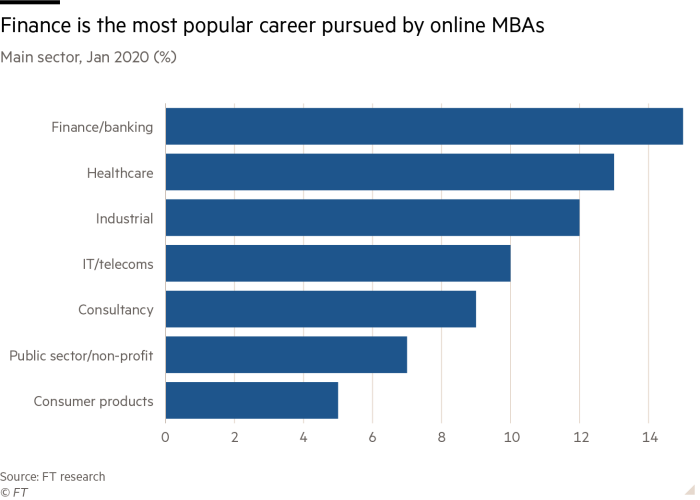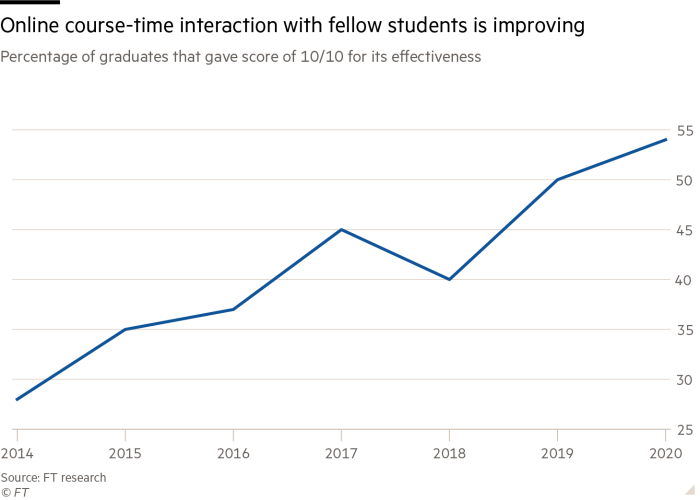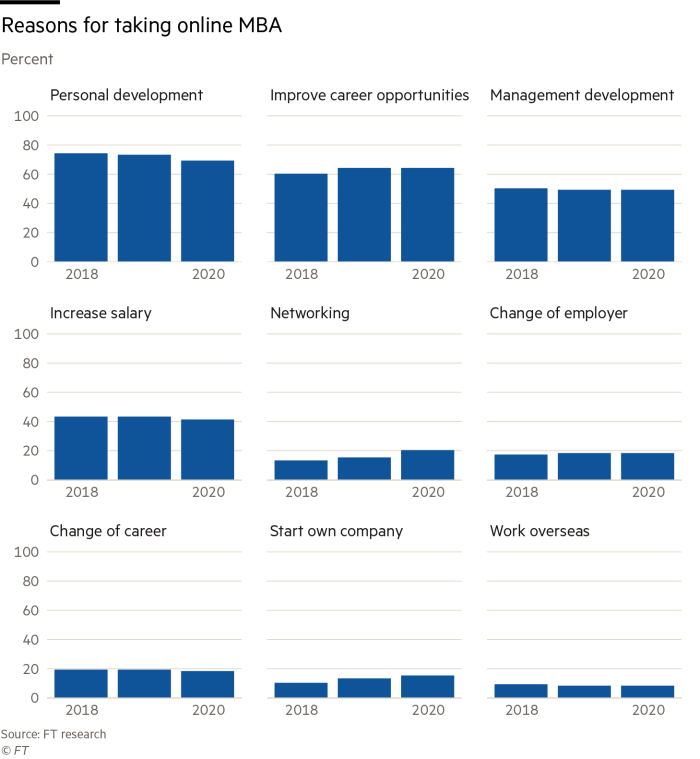Warwick’s online MBA leads FT ranking for third consecutive year
Roula Khalaf, Editor of the FT, selects her favourite stories in this weekly newsletter.
Warwick Business School is number one in the 2020 Financial Times ranking of online MBAs — the third consecutive year that it has taken the top slot.
The main factor in Warwick’s success is the salary that its alumni command: an average of $204,799 three years after graduation, a 40 per cent increase over that period. The school also ranks highest for career progression and for the percentage of international faculty — 78 per cent.
In second place, also for the third consecutive year, Spain’s IE Business School (which is the FT’s partner in Headspring, an executive development venture) has the highest percentage of international students at 91 per cent, as well as a 96 per cent international board.
Financial Times Online MBA table
Find out which 10 business schools have made it to the seventh edition of the FT MBA Online MBA ranking. Learn how the table is compiled below and read the full FT Online learning report.
Those interested in studying an Online MBA can use our directory to compare courses.
Students praise IE’s international exposure, and the networking opportunities it provides. The school also has the highest score for corporate social responsibility.
Alumni of the University of Massachusetts have the highest salary increase three years after graduation — 46 per cent — and the school also comes top for female faculty: 46 per cent of full-timers are women.

Indiana University’s Kelley scores highest for its careers service, programme delivery and research. Its alumni also highlight its strengths in teaching corporate strategy, entrepreneurship and ecommerce.
Newcomer Politecnico di Milano School of Management, ranked ninth overall, comes second for corporate social responsibility and third for online interaction.
“It was excellent to follow . . . lessons [at a distance] and to interact with participants from different countries,” was one graduate’s verdict.


Schools seem to have become better in the past few years at encouraging online interaction among their students — or perhaps students have become more comfortable with the format. Meanwhile people’s reasons for doing an online MBA have remained fairly constant: alumni cite personal development as the primary goal, followed by improved career opportunities and then management development.
This year’s ranking is based on surveys both of schools and of alumni who completed their online MBA in 2016. Although 22 schools took part, the alumni response rate was too low in some cases to allow more than half the schools to qualify for the final ranking.
Methodology: how the online MBA 2020 ranking was compiled
This is the seventh annual edition of the Financial Times ranking of the best online MBA programmes worldwide. A total of 22 schools took part.
All participating business schools must meet the FT’s strict entry criteria. The school must be accredited by AACSB or Equis and programmes must have run for four consecutive years. At least 70 per cent of the content must be delivered online. Course participants must pass a selection process before enrolling and an examination process before graduating.
Data were collected through two online surveys — the first was completed by participating schools and the second by their alumni who finished their online MBA in 2016. Some 650 of them completed our questionnaire — a response rate of about 21 per cent.
The ranking has 18 criteria. Alumni responses inform nine criteria that together contribute 65 per cent of the total weight. Another eight criteria are based on the school data, accounting for 25 per cent. The remaining criterion, the research rank, counts for 10 per cent.
Alumni-informed criteria
Alumni-informed criteria are based on data collected in the past three years. Responses from the 2020 survey carry 50 per cent of the total weight and those from 2019 and 2018 account for 25 per cent each. Excluding salary criteria, if only two years’ data are available, the weighting is split 60:40, if data are from 2020 and 2019, or 70:30, if data are from 2020 and 2018. For salary figures, the weighting is 50:50 for two years’ data.
The first two alumni criteria are average income three years after graduation and the salary increase compared with their pay on graduation, with respective weights of 20 per cent and 10 per cent. For the latter, half of the weight applies to the absolute increase and half to the percentage increase (the published figure). Salaries are converted to US dollars using the IMF purchasing power parity rates published in October 2019.
The salaries of non-profit and public sector workers and full-time students are removed, as are the highest and lowest salaries for each school, in order to calculate a normalised average. Finally, salaries are weighted to reflect differences between industry sectors.
“Value for money” for each school is calculated by dividing average alumni salary three years after graduation by the programme’s total cost, including tuition fees and other expenses. Any financial help given to alumni is subtracted from the total cost.
Business school criteria
School criteria include the diversity of staff, board members and students by gender and nationality. For gender criteria, schools with a 50:50 composition score the highest.
The corporate social responsibility category is based on the proportion of credits from core courses dedicated to CSR, ethics, social and environmental issues. It carries a weight of three per cent.
Research rank
The research rank is based on the number of articles by full-time faculty in 50 internationally recognised academic and practitioner journals. The rank combines the number of publications from January 2017 to December 2019, with the figure weighted relative to the size of the faculty.
The Online MBA ranking is a relative listing. Schools are ranked against each other by calculating a Z-score for each criterion. The Z-score is a statistic that shows where a score lies in relation to the mean. These scores are then weighted as outlined in the ranking key and added together for a final score.
After removing the schools that did not meet the response rate threshold from the alumni survey, a first version is calculated using all remaining schools. The school at the bottom is removed and a second version is calculated, and so on until the top 10 have been identified. The top 10 schools are ranked accordingly to produce the 2020 list.
Judith Pizer of Jeff Head Associates acted as the FT’s database consultant. The FT research rank was calculated using Clarivate Analytics data from the Web of Science, an abstract and citation database of research literature.
Key to the table
- Weighting percentages shown in brackets.
- For the three gender-related criteria, schools that have 50:50 (male: female) composition receive the highest score.
Salary today US$ (20): average alumnus salary three years after graduation, $ PPP equivalent (see methodology).†
Salary increase (10): percentage increase in alumnus salary in current job versus three years ago on graduation.†
Value for money (3): calculated according to alumnus salary, tuition, fees and other costs.†
Career progress (4): progression in alumni’s level of seniority and the size of company they now work for, versus three years ago on graduation.†
Aims achieved (4): extent to which alumni fulfilled their goals for taking an online MBA.†
Careers service (4): effectiveness of school careers service in terms of career counselling, personal development, networking events and recruitment, as rated by alumni.†
Programme delivery (5): how alumni rate the online delivery of live teaching sessions, other teaching materials and online exams.†
Online interaction (10): how alumni rate the interaction between students, teamwork and the availability of faculty.†
Female faculty (3): percentage of female members of faculty.
Female students (3): percentage of female students on MBA programme.
Women on board (1): percentage of female members of school advisory board.
International faculty (4): percentage of faculty whose citizenship differs from their country of employment.
International students (4): percentage of current students whose citizenship differs from the country the school is located in.
International board (2): percentage of board whose citizenship differs from the country in which the business school is situated.
International mobility (5): based on alumni citizenship and the countries where they worked before their MBA, on graduation and three years after.†
Faculty with doctorates (5): percentage of full-time faculty with a doctoral degree.
Corporate social responsibility rank (3): proportion of credits from core courses dedicated to CSR, ethics, social and environmental issues.
FT research rank (10): calculated according to the number of articles published by a school’s current full-time faculty members in 50 academic and practitioner journals between January 2017 and December 2019. The rank combines the absolute number of publications with the number weighted relative to the faculty’s size.
Additional notes
The following data are for information only and are not used in the ranking calculations.
Course tuition and fees (local currency): Programme tuition and fees paid by the most recently enrolled class, in the currency of the country where the school is situated. Figure shows weighted average.
Average completion time (years): The average amount of time students take to complete the programme.
Online teaching materials (%): Percentage of programme teaching materials that are delivered online.
† Includes data for the class of 2016 and one or two preceding classes where available.
Comments